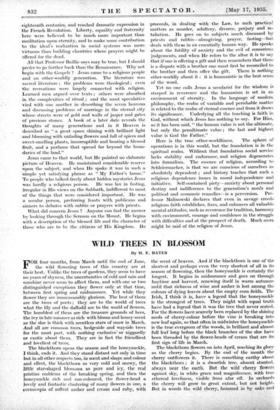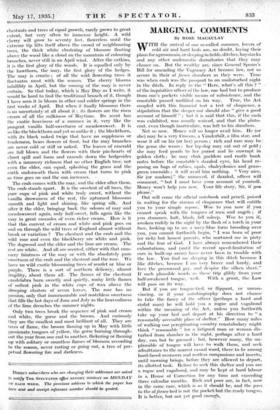WILD TREES IN BLOSSOM By H. E. BATES F OR four
months, from March until the end of June, the wild flowering trees of this country are at their best. Unlike the trees of gardens, they seem to have no years of shyness, the uncertainties of cold and rain and sunshine never seem to affect them, and with one or two distinguished exceptions they flower only at that time, :between first spring and midsummer. Yet while they flower they are immeasurably glorious. The best of them are the trees of poets ; they are to the world of trees what the lily and the daffodil are to the world of flowers. The humblest off them are the treasure grounds of bees, the ivy in late summer as rich with bloom and honey-scent as the sloe is thick with scentless stars of snow in March. -And all are common trees, hedgeside and wayside trees for the most part, with nothing exclusive' or niggardly or exotic about them. They are in fact the friendliest -and loveliest of trees.
The blackthorn opens the season and the honeysuckle, I think, ends it. And they stand distant not only in time but, in all other respects, too, in scent and shape and; colour and effect, the blackthorn so very cold and snowy, the little star-shaped blossoms so pure and icy, the real pristine emblems of the breaking spring, and then the honeysuckle rich and sun-coloured, the flower-head a lovely and fantastic clustering of many flowers in one, a cornucopia of softest amber and cream and ruby, with the scent of heaven. And if the blackthorn is one of the shortest and perhaps even the very shortest of all in its season of flowering, then the honeysuckle is certainly the longest. It begins in midsummer and goes on through haytime and harvest, renewing itself in warm autumns until that richness of wine and amber is lost among the colours of dying leaves about the empty corn fields. The Irish, I think it is, have a legend that the honeysuckle is the strongest of trees. They might with equal truth have had a legend that it was the tree that never rested. For the flowers have scarcely been replaced by the shining seeds of cherry-colour before the vine is breaking into new leaf again, so that often in midwinter the honeysuckle is the true evergreen of the woods, in brilliant and almost full leaf long before the black branches of the sloe have been threaded by the flower-beads of cream that are its first sign of life in March.
The blackthorn flowers on into April, reaching its glory as the cherry begins. By the end of the month' the cherry outfiowers it. There is something earthy about the blackthorn ; it is a dwarfish tree, almost stunted, always near the earth. But the wild cherry flowers against sky, in white grace and magnificence, with true ethereal loveliness, visible from afar off. In orchards the cherry will grow to great extent, but not height. But in woods the wild cherry, hemmed in by oaks and chestnuts and trees of equal growth; rarely grows to great extent, but very often to immense height. A wild cherry will grow to seventy feet, flowerless until the extreme tip lifts itself above the crowd of neighbouring trees, the thick White clustering of blossom floating above the wood like a cloud on the mountain of colouring branches, never still in an April wind. After the catkins, it is the first glory of the woods. It is equalled only by the hawthorn, the may, the first glory of the hedges. The may is erratic ; of all the wild flowering frees it fluctuates most with the season. The cherry blooms infallibly in April, but the coming of the may is never certain. So that today, which is May Day as I write, it would be hard to find the traditional branch of it, though I have seen it in bloom in other and colder springs in the first weeks of ,April. But when it finally blossoms there is no uncertainty at all about it ; its flowers are the risen cream of all the milkiness of •Maytime. Its scent has the exotic heaviness of a summer, in it, very like the • pungent vanilla half-sweetness of meadowsweet. It is so like the blackthorn and yet so unlike it ; the blackthorn, with its black naked twigs that have no suppleness or tenderness, bears flowers of frost, but the may branches are never cold or stiff or naked. The leaves of emerald are full blown and the flowers with their pin-hearts of claret spill and. foam and cascade down the hedgesides with a summery richness that no other English tree, not even the elder, can equal, splashing the grass and the earth underneath them with cream that turns to pink as time goes on and the sun increases. - The crab comes with the may, and the elder after them. The crab stands apart. It is the sweetest of all trees, the pure cups of pink and white truly sweet, without the vanilla drowsiness of the rest, the upturned blossoms smooth and light and shining, like spring silk. And after it the elder, bringing back the odours of may and meadowsweet again, only half-sweet, falls again like the may in great cascades of even richer cream. How is it that this current of cream and white and pink goes on and on through the wild trees of England almost without break or variation ? The chestnut and the crab anti the wild rose and even the blackberry are white and pink. The dogwood and the elder and the lime are cream. The rest are white. And all areseented, either with that sum- mery faintness of the may or with the absolutely pure ' sweetness of the crab and the chestnut and the rose. We have no wild exotic blossoming trees of scarlet br blue or purple. There is a sort of northern delicacy, almost fragility, about them all. The flames of the chestnut candelabra burn sweetly and quietly, many little flames of softest pink in the white cups , of wax above the dtooping clusters of seven lead es. The rose has no passion, only that immeasurable and Matchless sweetness that fills the hot days of June and July as the heavenliness of the lime drenches the summer nights.
Only two. trees break the sequence .of. pink and cream and white, the •gorse and the broom. And curiously they are the smallest and most brilliant of all. They are trees of flame, the broom flaming up in May with little p,assionatejongnes of yellow, the gorse burning through-, out the year from one end to another, flickering or flaming up with solitary or countless flames of blossom according to the' season, never resting or going out, a tree of per- petual flowering fire and darkness.











































 Previous page
Previous page